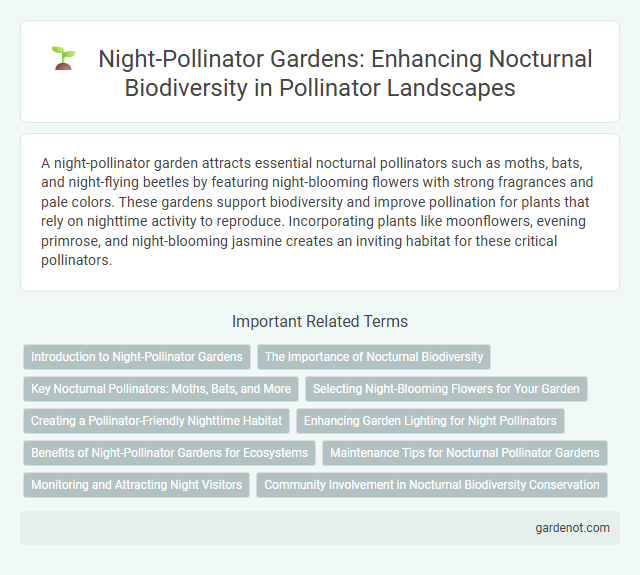A night-pollinator garden attracts essential nocturnal pollinators such as moths, bats, and night-flying beetles by featuring night-blooming flowers with strong fragrances and pale colors. These gardens support biodiversity and improve pollination for plants that rely on nighttime activity to reproduce. Incorporating plants like moonflowers, evening primrose, and night-blooming jasmine creates an inviting habitat for these critical pollinators.
Introduction to Night-Pollinator Gardens
Night-pollinator gardens create habitats designed to attract nocturnal pollinators such as moths, bats, and certain beetles. These gardens feature night-blooming flowers that emit strong scents and pale colors, which are easier to detect in low light conditions. Incorporating native plants like evening primrose and moonflower supports biodiversity and enhances nighttime ecosystem services.
The Importance of Nocturnal Biodiversity
Night-pollinator gardens support a diverse range of nocturnal species such as moths, bats, and beetles, which play a crucial role in pollination and ecosystem health. Preserving nocturnal biodiversity ensures continuous plant reproduction and maintains the balance of food webs, promoting overall environmental resilience. These gardens also contribute to the conservation of species whose activities occur outside typical daylight hours, enhancing urban and rural biodiversity alike.
Key Nocturnal Pollinators: Moths, Bats, and More
Night-pollinator gardens support vital nocturnal pollinators such as moths, bats, and certain beetles that thrive in low-light environments. These species play a key role in pollinating night-blooming plants, contributing to biodiversity and ecosystem health. Designing gardens with fragrant flowers, white or pale colors, and ample shelter encourages visits from these important night pollinators.
Selecting Night-Blooming Flowers for Your Garden
Choosing night-blooming flowers like evening primrose, moonflower, and night-blooming jasmine attracts essential night pollinators such as moths, bats, and nocturnal bees. These plants release strong fragrances and produce pale or white flowers that are easier for night pollinators to locate in low light. Incorporating native night-blooming species enhances local biodiversity and supports the ecosystem by providing vital nectar sources during nighttime hours.
Creating a Pollinator-Friendly Nighttime Habitat
Designing a night-pollinator garden involves selecting native, night-blooming plants like evening primrose and moonflowers that attract moths, bats, and other nocturnal pollinators. Incorporating features such as water sources, sheltering shrubs, and avoiding artificial lighting enhances habitat suitability and supports biodiversity. This targeted environment promotes effective pollination cycles and sustains ecosystems reliant on nighttime pollinator activity.
Enhancing Garden Lighting for Night Pollinators
Enhancing garden lighting for night pollinators involves using low-intensity, warm-colored LED lights to minimize disruption to nocturnal insects like moths and beetles. Strategic placement of lights away from key flowering plants preserves natural pollination behavior while enabling better observation and safety. Incorporating motion-activated or dimmable lighting systems balances human needs with the ecological requirements of night pollinators in the garden.
Benefits of Night-Pollinator Gardens for Ecosystems
Night-pollinator gardens support biodiversity by attracting nocturnal pollinators such as moths, bats, and beetles, which play crucial roles in pollinating night-blooming plants. These gardens enhance ecosystem resilience by facilitating pollination during cooler nighttime hours, preventing competition with daytime pollinators and promoting plant species diversity. Incorporating native night-flowering plants creates habitats that sustain nocturnal wildlife, contributing to balanced food webs and healthier environments.
Maintenance Tips for Nocturnal Pollinator Gardens
Night-pollinator gardens thrive when maintained with careful attention to plant health and appropriate watering schedules that suit evening-active species like moths and bats. Selecting native night-blooming plants and regularly removing invasive species supports a balanced ecosystem, enhancing pollinator attraction and biodiversity. Minimal use of artificial lighting preserves natural nocturnal rhythms, ensuring effective pollination and sustaining night-pollinator populations.
Monitoring and Attracting Night Visitors
Monitoring night-pollinator gardens requires specialized tools such as infrared cameras and UV light traps to observe nocturnal visitors like moths, bats, and beetles. Selecting native night-blooming plants with strong fragrances and pale-colored flowers enhances attraction by providing nectar and pollen resources during darkness. Regular data collection on visitation rates and species diversity supports effective habitat management and biodiversity conservation efforts.
Community Involvement in Nocturnal Biodiversity Conservation
Night-pollinator gardens engage local communities in preserving nocturnal biodiversity by creating habitats that attract moths, bats, and other night-active pollinators crucial for ecosystem balance. Community-led workshops and volunteer programs foster awareness and participation, enhancing conservation efforts through habitat restoration and native plant cultivation. Collaborative monitoring initiatives provide valuable data on nocturnal species, strengthening scientific understanding and promoting sustainable urban wildlife practices.
Night-pollinator garden Infographic

 gardenot.com
gardenot.com